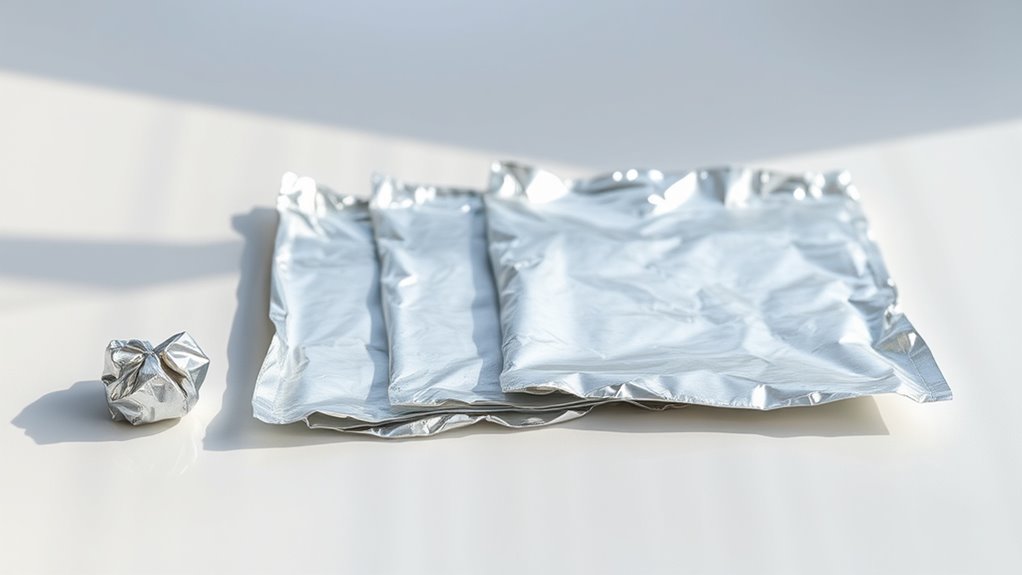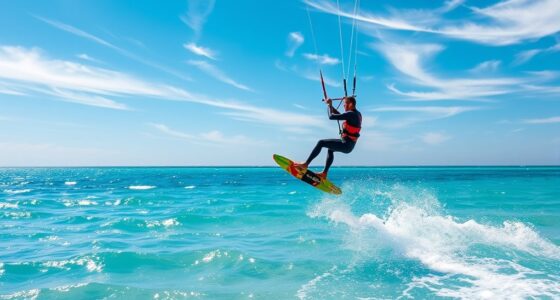Choosing the right foil size depends on your skill level and riding goals. Larger foils offer more stability and lift, making them ideal for beginners, while smaller sizes favor agility and speed for advanced riders. Material and design features also play a role in performance, with lighter, stiffer options enhancing responsiveness. Understanding these sizes helps you pick the perfect foil to boost your water sport experience—continue exploring to find out which size suits you best.
Key Takeaways
- Larger foils (around 900-1200cm²) offer more stability and are ideal for beginners learning control and balance.
- Medium-sized foils (around 700-900cm²) provide a balance of stability and maneuverability suitable for intermediate riders.
- Smaller foils (below 700cm²) enhance speed and agility, favored by advanced riders for quick turns and high performance.
- Material choices like carbon fiber increase responsiveness and reduce weight, benefiting experienced riders seeking precision.
- Design features such as wing shape and stabilizer adjustments allow customization for skill level and riding conditions.

Choosing the right foil size is essential whether you’re just starting out or aiming to perfect your skills. The size you select influences your control, stability, and overall performance in the water. When it comes to material types, you’ll find foils made from aluminum, carbon fiber, and composite materials. Aluminum foils are usually more affordable and durable, making them ideal for beginners who want a reliable option without a hefty price tag. Carbon fiber foils, on the other hand, are lighter and stiffer, offering enhanced responsiveness and agility, which pros often prefer for speed and precision. Composite materials strike a balance between the two, providing a good mix of durability, weight, and cost-effectiveness. The choice of material impacts not only your ride quality but also your learning curve, as lighter, stiffer foils like carbon fiber can be more responsive but also more sensitive to weight distribution and technique. Additionally, understanding foil design features can help you select a model that aligns with your riding goals and water conditions. Design innovations play a significant role in how different foil sizes perform. Modern designs have introduced features like optimized wing shapes, adjustable stabilizers, and modular components that can be customized to fit your skill level and water conditions. For beginners, foils with wider wings and larger surface areas offer more lift and stability, helping you stay balanced and confident as you learn. As you progress, you might prefer smaller, more agile foils that allow for quicker turns and higher speeds. Innovations such as thicker profiles or tapered wings improve stability at lower speeds, while thinner, more streamlined designs enhance top-end speed and maneuverability. These design innovations constantly evolve, giving you options to tailor your gear to your specific riding style and environment. When selecting a foil size, consider how material types and design innovations influence your experience. Larger foils with advanced materials like carbon fiber can provide a smoother, more controlled ride, making them a good choice for beginners who want stability. Conversely, smaller, high-performance foils with cutting-edge design features are better suited for experienced riders aiming for speed and agility. The key is understanding how these factors interact: material choices affect durability and weight, while design innovations determine how the foil responds to your movements. By considering these elements, you can find a foil size that not only matches your current skill level but also supports your growth as a rider.
Frequently Asked Questions
How Do Foil Sizes Affect Overall Flight Performance?
Smaller foils make your ride more agile and responsive, but may reduce hydrodynamic efficiency and lift. Larger foils boost stability and lift, enhancing overall flight performance, especially in rough waters. The size also impacts material durability—bigger foils often need stronger materials to withstand pressure. So, choosing the right foil size depends on your skill level and riding style, balancing hydrodynamic efficiency and material durability for ideal performance.
Are Larger Foils Suitable for Beginners?
Larger foils are generally not beginner-friendly options because they can be harder to control and require more skill to manage. As an entry-level gear choice, smaller foils offer more stability and easier learning, making them perfect for those just starting out. If you’re a beginner, stick with beginner-friendly options to build confidence and skill before trying larger foils, which are better suited for advanced riders.
What Is the Most Versatile Foil Size for All Conditions?
Think of the most versatile foil size as the Swiss Army knife of your kit. It adapts to various conditions, making it perfect whether you’re cruising or pushing limits. When choosing, consider foil material and manufacturing techniques, as these influence durability and performance. A mid-sized foil offers a balance, allowing you to switch gears effortlessly, just like a seasoned sailor adjusting to changing winds. This size truly masters all environments.
How Do Weight and Skill Level Influence Foil Size Choice?
Your weight and skill level greatly influence foil size choice because they affect foil stability and maneuverability trade-offs. If you’re heavier, you’ll benefit from a larger foil for better stability, but it might reduce maneuverability. Beginners should opt for smaller, more maneuverable foils to develop control, while experienced riders can handle larger foils to maximize stability. Adjusting foil size based on your weight and skills guarantees ideal performance and enjoyment on the water.
Can I Upgrade My Foil Size Later On?
Yes, you can upgrade your foil size later on. As you gain experience, you might prefer different foil materials or manufacturing techniques that suit your riding style. When upgrading, consider how a larger or smaller foil impacts your control and speed. Make certain to choose a compatible size and material that match your skill level and goals, and consult with experts if needed to guarantee a smooth progression.
Conclusion
Now that you’ve uncovered the secrets behind these six foil sizes, you’re ready to navigate the skies with confidence. Think of each size as a different brushstroke on your journey—small for precision, large for power. With every flight, you’re painting your own masterpiece, mastering balance and control. Embrace the symbolism of the foil as your wings, guiding you from beginner to pro. Your skyward adventure begins now—so spread those wings and soar.







